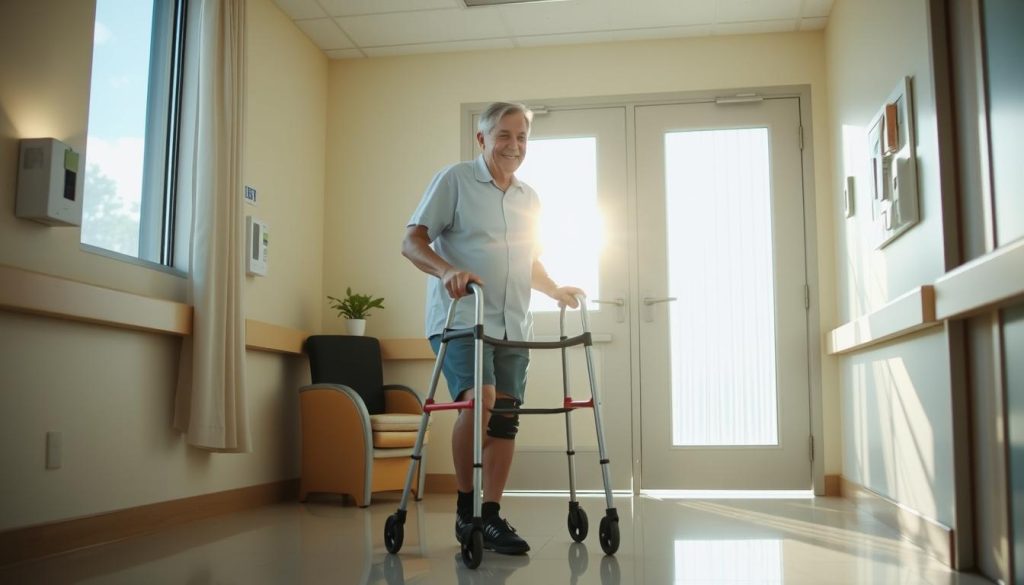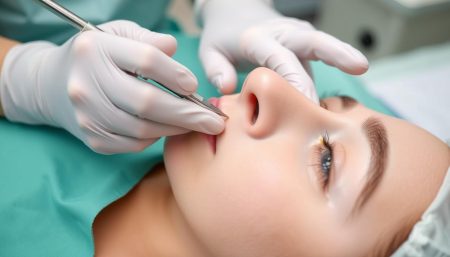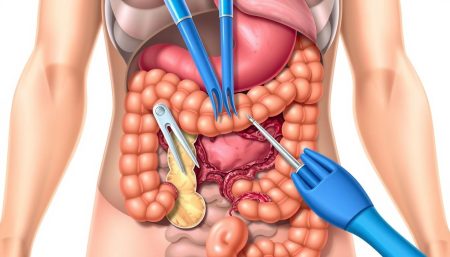After knee replacement surgery, getting back on your feet is key. You might wonder if inpatient rehab benefits for knee replacement surgery are worth it. This could greatly improve your post-surgical outcomes.
Many patients and their families ask: is inpatient rehabilitation really needed? We’ll look into the various recovery paths and how inpatient care can help.
Knowing about different recovery options is important. This includes the services of top knee replacement surgery rehabilitation centers. It helps patients choose what’s best for their health.
We’re here to discuss the benefits of inpatient care. Let’s see how it can make your recovery smoother.
Understanding Knee Replacement Surgery
Knee replacement surgery is a big step for those with severe joint pain and mobility issues. This section explains knee replacement surgery and the recovery options. It helps patients know what to expect and why recovery is so important.
The Procedure Explained
Knee replacement surgery replaces the damaged parts of the knee with artificial ones. These parts are made of metal and plastic. They help the knee move naturally again. Before the surgery, patients go through many tests to make sure it’s right for them.
Reasons for Undergoing Knee Replacement
People get knee replacement surgery for severe arthritis, trauma, and other diseases. It’s usually chosen when other treatments don’t work.
Risks and Considerations
Knee replacement surgery has risks like infections and blood clots. It’s important to know these risks before surgery. This helps patients prepare well.
It’s key to understand the surgery and recovery fully. Here are some things to think about when getting ready for surgery and recovery:
| Consideration | Details |
|---|---|
| Pre-operative Assessment | Patient’s health evaluation to identify any underlying conditions that could affect surgery success. |
| Post-operative Care | Includes pain management, physical therapy, and monitoring for any complications, which are vital for recovery. |
| Recovery Environment | Choosing between inpatient rehab and home recovery, each has its own benefits for the patient. |
| Long-term Care | Regular check-ups to watch the implant, making lifestyle changes, and possibly more surgeries. |
Knowing all about the surgery and recovery helps prepare better. Patients should talk to their doctor about these things. This way, they can plan for a successful recovery.
Do Knee Replacement Surgery Patients Go to Inpatient Rehab
Choosing inpatient rehabilitation after knee replacement depends on several factors. These include the surgery’s extent, the patient’s health, and personal choices. It’s important to know about postoperative care for knee replacement patients to decide on recovery paths.
Many patients after knee replacement surgery are advised to go to inpatient rehab. This type of rehab offers intense care and therapy. It aims to improve the knee’s function after surgery.
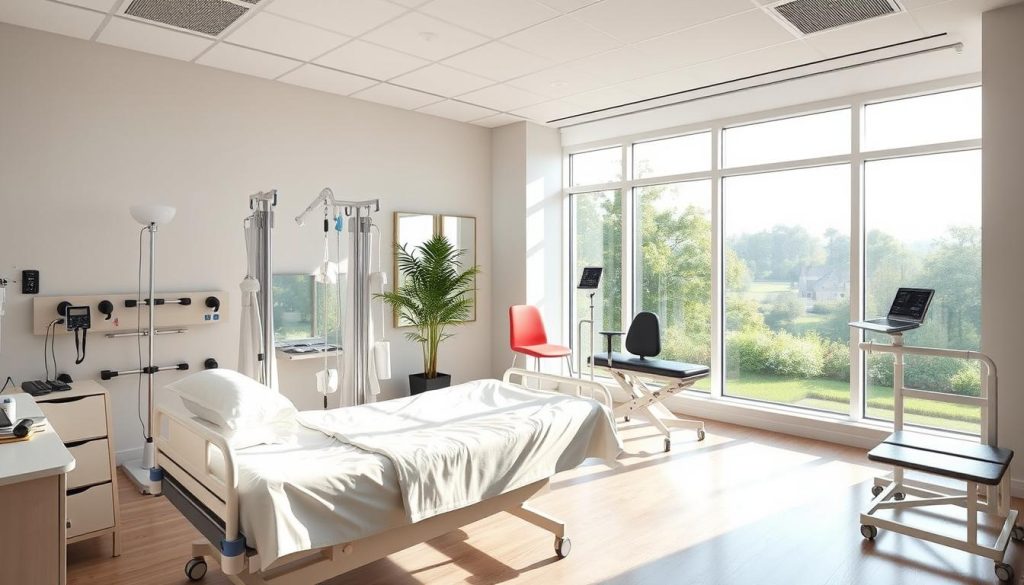
The benefits of inpatient rehab extend beyond physical recovery, providing support for emotional and psychological needs as well.
Deciding on inpatient rehab depends on surgery complexity and pre-surgery mobility. More complex surgeries and lower mobility levels often lead to inpatient rehab recommendations. Inpatient care offers constant medical watch, vital in the early recovery stages.
Recent studies and surveys have shown the importance of postoperative care for knee replacement patients. They highlight how structured rehab impacts outcomes and recovery times. This makes a big difference between inpatient and home care settings.
In conclusion, not all knee replacement patients need inpatient rehab. But, it’s a key option for many, based on medical advice and individual needs. It’s a vital part of care for the best recovery and long-term results.
The Role of Inpatient Rehabilitation After Knee Replacement
After knee replacement surgery, recovery is more than just healing. Inpatient rehab centers are key for a full recovery. They offer therapy options in inpatient rehab tailored for each patient’s needs.
Inpatient rehab centers have a special setup for quick recovery. Patients get 24/7 medical care and help. This reduces recovery risks and helps patients get stronger and move better faster.
| Rehab Feature | Benefits |
|---|---|
| Personalized Physical Therapy | Helps patients move better and get stronger |
| Round-the-Clock Nursing Care | Quick help with pain and any problems |
| Collaborative Treatment Planning | Many healthcare experts work together for care |
| Equipment and Facilities | Special tools and safe places for rehab |
The heart of rehab is the therapy options in inpatient rehab. This includes physical, occupational, and hydrotherapy. These therapies help patients get back to their old selves.
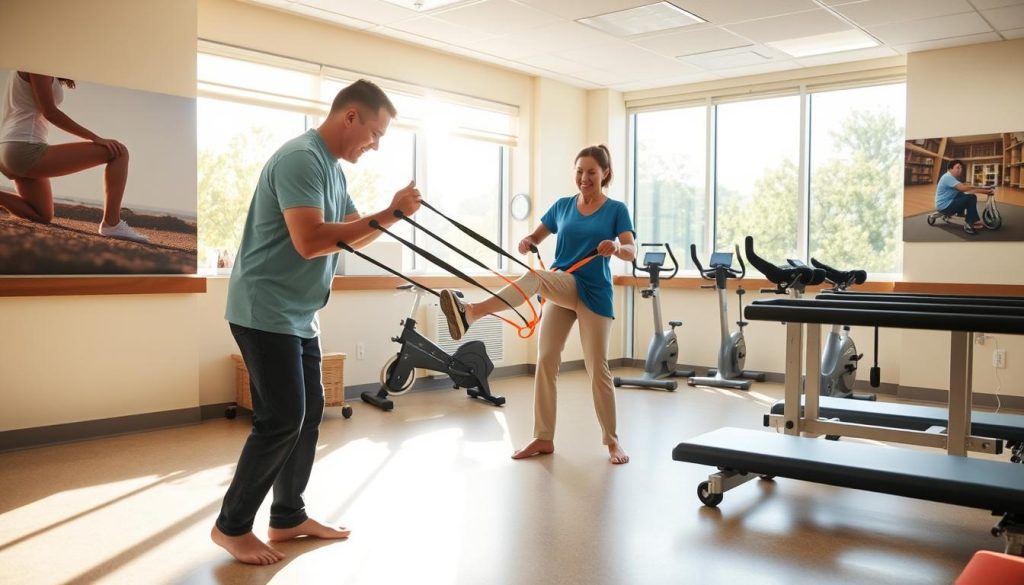
Structured therapy sessions are key. They help avoid injuries from doing too much too soon. The care teams teach patients how to care for their joints and move right after surgery.
In short, inpatient rehab centers offer a complete care plan for knee replacement recovery. Having expert teams and therapy options in inpatient rehab helps patients recover well. They get back to living a better life.
Comparing Inpatient and Outpatient Knee Surgery Recovery Options
Choosing between outpatient and inpatient rehab for knee surgery recovery is a big decision. Each option has its own benefits and things to consider. This section will help you understand the differences. It aims to guide you in making a choice that fits your health needs and lifestyle.
What Outpatient Rehab Entails
Outpatient rehab means you go home right after surgery. You then get physical therapy at clinics or even at home. This way, you can fit therapy into your busy schedule and recover in your own space.

Benefits of Recovering at Home
Choosing outpatient rehab can make you feel more comfortable and happy. Being at home lets you plan your recovery around your life. It also means you can get support in a place you know well, which can reduce stress.
Having family involved in your rehab can also help. It strengthens your bond and makes you feel more supported. This creates a better environment for healing.
When deciding between outpatient and inpatient rehab, think about several things. Consider your health, the support at home, and what you prefer. Knowing the details of each option will help you make a choice that’s right for you.
Typical Postoperative Care for Knee Replacement Patients
Knee surgery recovery process and post-surgical care protocols are key for knee replacement patients. They help manage pain, prevent issues, and start the healing needed to get back to normal. This part talks about the usual care given to these patients.
Right after surgery, patients are watched closely in a recovery room. Here, their vital signs and how they’re doing after surgery are checked. Pain management starts quickly, using different medicines to help with pain and encourage moving around. A typical knee surgery recovery timeline has important milestones that doctors use to make sure recovery goes well.
- Initial 24 hours: Pain management and early mobility
- Day 2-3: Implementation of gentle physical therapy
- Week 1-2: Incremental increase in mobility and continuation of pain management
- Month 1-3: Transition to outpatient physical therapy as mobility improves
Following a personalized care plan is a big part of post-surgery care. This plan is made just for each patient. It takes into account things like age, health, and how active they were before surgery.
| Timeline | Key Focus | Typical Activities |
|---|---|---|
| Immediate Post-Surgery | Pain Management | Medication, ice application, elevation |
| First Few Days | Mobility | Assisted walking, gentle exercises |
| Following Weeks | Physical Therapy | Structured exercises, outpatient sessions |
By following these care protocols, patients can have a smoother knee surgery recovery process. It’s also key for getting back to their usual activities and lifestyle. Sticking to the care plan greatly improves recovery results.
Benefits of Inpatient Rehab for Knee Replacement Surgery
Choosing inpatient rehab after a knee replacement can greatly improve your recovery. The advantages of inpatient rehab include more than basic care. You get intensive supervision and access to specialized therapies for knee replacement.
Intensive Care and Monitoring
Inpatient rehab offers intense care and constant monitoring. Healthcare professionals are always there to manage pain and check your progress. They can quickly spot and fix any problems.
Access to Specialized Therapies
You also get to try out many specialized therapies. These include hydrotherapy, physiotherapy, and occupational therapy. These therapies are not always available at home and help your knee heal better.
Social Support Systems in Inpatient Settings
Inpatient rehab also has strong social support systems. Talking with others who are going through the same thing helps a lot. The staff’s encouragement also boosts your mood and motivation.
These factors mean you get top-notch medical care and emotional support. It’s all about helping you recover fully.
| Feature | Inpatient Rehab | Outpatient Rehab |
|---|---|---|
| Intensity of Care | High, with 24/7 monitoring | Moderate, periodic check-ins |
| Therapy Options | Multidisciplinary and specialized | Limited, often standard |
| Social Support | Inclusive, community-based | Limited interactions |
| Safety Monitoring | Continuous by healthcare staff | Dependent on self-reporting or appointments |
| Recovery Environment | Controlled and designed for rehab | Home, varies by patient setting |
Inpatient Rehabilitation After Knee Replacement: What to Expect
Starting inpatient rehab after knee surgery means a detailed plan to help you heal and move better. You’ll get physical and occupational therapy to boost knee function and daily skills. Knowing what therapy does helps you understand your recovery better.
Physical Therapy Regimen
Inpatient rehab has a strict physical therapy schedule. It aims to lessen pain, strengthen knee muscles, and improve joint movement. This hard work helps you recover faster, thanks to care from skilled therapists.
Therapists use exercises, balance training, and resistance workouts. They adjust these based on your progress and how much pain you’re in.
Occupational Therapy Inclusions
Occupational therapy is key in rehab, teaching you for daily and work tasks. After knee surgery, it helps you adjust to life with a new joint. You’ll learn to use devices and protect your joint.
This approach helps you regain function and independence. It’s a big part of getting back to your normal life.

- Targeted knee exercises to improve range of motion
- Pain management techniques
- Training in the use of mobility aids
- Cognitive exercises for joint care and activity planning
Both physical and occupational therapies are vital for recovery. They help you not just get better but also adjust to your new life after surgery. By fully taking part in therapy, you’ll see big improvements in how you move and feel less pain.
Evaluating If Inpatient Rehab is Right for You
Choosing the right place for rehab after knee surgery is key for a good recovery. You need to think about your health needs and your home environment. Also, get advice from healthcare providers on the best rehab for you.
Assessing Your Personal Needs
Consider your health, home support, and how complex your surgery was. These factors are important when deciding on rehab. It’s the first step to choosing the right path for your recovery.
Discussing Options with Healthcare Providers
Talking to your healthcare provider about rehab options is essential. They can help you understand the pros and cons of inpatient and outpatient care. This way, you can choose a rehab plan that fits your recovery and lifestyle.
Here’s how these factors might match up with your post-surgery needs:
| Consideration | Inpatient Rehab Benefits | Outpatient Rehab Benefits |
|---|---|---|
| Physical Health Status | 24/7 medical support and immediate post-surgical care | Flexibility to schedule therapy sessions |
| Home Environment | N/A – all care provided on-site | Comfort of recovering in a familiar setting |
| Recovery Goals | Intensive, structured therapy sessions | Customized therapy adapted to individual pace |
In conclusion, choosing between inpatient or outpatient rehab is a big decision. It should be based on your personal needs and advice from healthcare providers. This careful planning ensures a recovery that is both effective and comfortable for you.
Knee Replacement Recovery Facilities
The quality of facilities for knee replacement recovery is key. Patients have many options, from top-rated centers to hospital units. Knowing what each offers helps patients choose the best care.
Top centers focus on both medical care and a healing environment. They use advanced therapy and comfortable spaces. This makes recovery smoother and more effective.
- Personalized care plans tailored to each patient’s specific medical needs
- Access to a team of specialists knowledgeable in orthopedic recovery
- Therapeutic amenities such as pools, gardens, and fitness centers designed to aid recovery
- Comfortable accommodations that provide a peaceful atmosphere for healing
Modern facilities aim to enrich the recovery environment. They offer everything from therapy sessions to relaxation spaces. This holistic approach supports both body and mind.
Choosing a rehab center is about more than medical care. It’s about the quality of life and support during recovery. Today’s best centers offer both, setting the stage for successful recovery.
Finding the Best Rehab Facilities for Knee Replacement Patients
Choosing the right rehab facility for knee replacement recovery is key. It’s about finding a place that helps you get back to full mobility. The right choice can make a big difference in your recovery.
When looking at rehab centers, check how well they meet quality standards. Look at the qualifications of the staff, the therapy options, and how happy patients are.
- Accreditation and Standards: Make sure the facility follows national health care standards and is accredited.
- Customized Treatment Plans: Choose centers that offer personalized plans for each patient’s needs after surgery.
- Patient Outcomes: Check the success rates and read what other patients say to see how well the rehab works.
| Criteria | Description | Importance |
|---|---|---|
| Staff Expertise | Qualified physical therapists specialized in orthopedic and knee rehabilitation. | High |
| Equipment and Facilities | State-of-the-art equipment and facilities designed for knee recovery. | Crucial |
| Recovery Support | Availability of complete support services, including nutritional advice and psychological counseling. | Essential |
Focus on these key factors and do your homework to find the best rehab for your knee surgery recovery. This way, you’ll meet the quality measures in knee replacement rehabilitation you’re looking for.
Success Stories from Knee Replacement Surgery Rehabilitation Centers
Many people have seen great results from top-notch care in rehab centers. They’ve had successful knee replacement recoveries. These stories show how rehab centers tailor care and have high rehabilitation center success rates.
Patients’ Journeys to Recovery
Patients who got knee replacements say rehab changed their lives. They got back their mobility and independence thanks to detailed recovery plans. The teamwork of doctors, physiotherapists, and nurses is key to better outcomes and a better life.
“The dedicated support from the rehab staff and the tailored exercises significantly improved my mobility within weeks,” shared a patient about their rehabilitation experience.
How Rehab Centers Facilitate Success
Rehab centers are vital for successful knee replacement recoveries. They use proven therapies to help patients. Their success rates are high because they focus on pain management, physical therapy, and mental support. They aim to help patients live active lives again.
Studies, like one by the Hospital for Special Surgery, show good results from both home and inpatient rehab. This shows that current rehab methods work well.
| Patient Outcome | Rehabilitation Center | At-Home Care |
|---|---|---|
| Physical Mobility | High improvement | Moderate improvement |
| Pain Management | Effectively managed | Self-managed |
| Patient Satisfaction | Very High | High |
The hard work and commitment of patients and healthcare teams make rehab centers great places for recovery. It’s clear that with the right care, people can live active and happy lives after knee replacement surgery.
Insurance and Cost Considerations in Choosing Inpatient Rehab
Choosing the right rehabilitation facility after knee surgery is a big decision. It’s influenced by insurance coverage for knee surgery rehab and the affordability of inpatient rehab. This section will help you understand how to make a choice that fits your budget.
Navigating Insurance Coverage for Rehab
Knowing what your insurance covers can make a big difference. Most plans help with some rehab costs, but the details vary. It’s best to talk directly to your insurance to find out what’s included.
Ask about any costs you might have to pay yourself. Knowing this can help you plan better for your recovery.
Cost-effective Rehabilitation Options
Inpatient rehab can be expensive. But, there are ways to make it more affordable. Start by finding facilities that work with your insurance.
Some places offer payment plans or help for those who can’t pay upfront. Also, comparing different rehab centers can help you find a good deal without sacrificing quality.
In conclusion, dealing with insurance coverage for knee surgery rehab and finding affordable options can be tough. But, with the right information, you can make a choice that’s both smart and affordable.
Inpatient Vs. At-Home Rehab: Making an Informed Decision
Choosing between inpatient and at-home rehab for knee replacement surgery is key. This choice affects your recovery quality and long-term rehab benefits. Inpatient rehab offers a structured setting with professional care and equipment. At-home rehab focuses on comfort and personal space.
Each option has its advantages and disadvantages. What works for one person might not be the best for another. This depends on health and lifestyle factors.
Quality of Life During Recovery
Quality of life is a big concern when picking rehab. Inpatient facilities provide constant medical care and pain management. They also offer a community of health professionals and patients.
At-home rehab, on the other hand, lets you recover in a familiar setting. Being surrounded by family and personal items can reduce stress. It can also boost emotional well-being.
Long-term Outcomes
Looking at long-term outcomes is also important. Inpatient rehab might lead to faster improvements in mobility and strength. This could mean a more significant long-term recovery.
At-home rehab, while requiring discipline, can be effective with the right program and guidance. For more on therapy’s impact, check out CAR T cell therapy information. It shows the value of personalized healthcare.
FAQ
Q: Is inpatient rehab necessary after knee replacement surgery?
A: Not always, but it’s helpful for those needing intense care or have health issues. Talk to your healthcare team to decide what’s best for you.
Q: What does knee replacement surgery involve?
A: It removes damaged parts of the joint and replaces them with artificial ones. This surgery helps reduce pain and improve movement for those with severe knee damage.
Q: Why might someone undergo knee replacement surgery?
A: People often choose this surgery for ongoing pain, stiffness, and limited function. This is due to conditions like osteoarthritis or arthritis that don’t get better with other treatments.
Q: What are the risks associated with knee replacement surgery?
A: Risks include infections, blood clots, and problems with the implant. There’s also a chance of ongoing pain and needing more surgeries. Knowing these risks is key before surgery.
Q: Do knee replacement surgery patients typically go to inpatient rehab?
A: Yes, many go to inpatient rehab. This is true for those needing special care, living alone, or have other health issues that could make recovery harder.
Q: What therapies are offered in inpatient rehabilitation for knee replacement?
A: You’ll get physical therapy, occupational therapy, and sometimes hydrotherapy or electrical stimulation. These therapies aim to help you recover better.
Q: What is the difference between inpatient and outpatient knee surgery recovery options?
A: Inpatient rehab offers intense care and therapy sessions. Outpatient rehab lets you recover at home with less frequent therapy sessions.
Q: What does standard postoperative care for knee replacement patients include?
A: Care includes managing pain, wound care, physical therapy, and watching for complications. Moving early and following a recovery plan are very important.
Q: What are the benefits of inpatient rehab for knee replacement surgery?
A: Benefits include constant monitoring, access to special therapies, and support from a team. This can lead to better results and lower risks of complications.
Q: What should patients expect in inpatient rehabilitation after knee replacement?
A: You’ll get a set therapy plan with exercises to improve movement and strength. You’ll also learn to do daily tasks on your own.
Q: How should one decide if inpatient rehab is the right choice?
A: Think about your health, what you prefer, where you live, and your recovery goals. Then talk to your healthcare provider to make a good choice.
Q: What factors should be considered when finding the best rehab facility for knee replacement?
A: Look at the facility’s reputation, success rates, quality, therapies offered, and patient feedback. This ensures you get the best care.
Q: How do rehab centers contribute to the success of knee replacement surgery patients?
A: Rehab centers offer a full approach with personalized plans, professional support, and encouragement. This helps patients regain function and improve their life quality.
Q: What are important insurance and cost considerations when choosing inpatient rehab?
A: Know your insurance, what you’ll pay out-of-pocket, and look for funding help. This makes inpatient rehab more affordable.
Q: How do inpatient and at-home rehab compare in terms of affecting quality of life and long-term outcomes?
A: Inpatient rehab provides a structured setting, which can be comforting for some. At-home rehab offers comfort and flexibility. Both can lead to good long-term results if they meet your needs.












